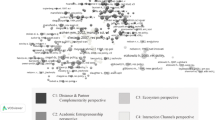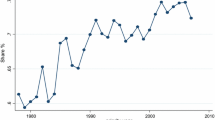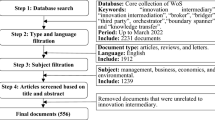Abstract
The study of university–industry (U–I) relations has been the focus of growing interest in the literature. However, to date, a quantitative overview of the existing literature in this field has yet to be accomplished. This study intends to fill this gap through the use of bibliometric techniques. By using three different yet interrelated databases—a database containing the articles published on U–I links, which encompass 534 articles published between 1986 and 2011; a ‘roots’ database, which encompasses over 20,000 references to the articles published on U–I relations; and a ‘influences’ database which includes more than 15,000 studies that cited the articles published on U–I relations—we obtained the following results: (1) ‘Academic spin offs’, ‘Scientific and technological policies’ and (to a greater extent) ‘Knowledge Transfer Channels’ are topics in decline; (2) ‘Characteristics of universities, firms and scientists’, along with ‘Regional spillovers’, show remarkable growth, and ‘Measures and indicators’ can be considered an emergent topic; (3) clear tendency towards ‘empirical’ works, although ‘appreciative and empirical’ papers constitute the bulk of this literature; (4) the multidisciplinary nature of the intellectual roots of the U–I literature—an interesting blending of neoclassical economics (focused on licensing, knowledge transfer and high-tech entrepreneurship) and heterodox approaches (mainly related to systems of innovation) is observed in terms of intellectual roots; (5) the influence of the U–I literature is largely concentrated on the industrialized world and on the research area of innovation and technology (i.e., some ‘scientific endogamy’ is observed).









Similar content being viewed by others
Notes
The combinations used included also the several synonymous of ‘university and industry’, namely: ‘science and industry’; ‘university and firm’; and ‘university and business’.
All the cited and citing references had to be harmonized in terms of the authors’ and sources’ names and titles—this was a painstaking and time-consuming task but deemed necessary in order to obtain a rigorous picture of the authors and outlets that most influenced and were influenced by the U–I literature. It is worth to note that a cited work is a paper or book that has been mentioned in the references of other works, and the citing work is the one that contains the references (Garfield 1994).
References
Abramo, G., D’Angelo, C. A., Di Costa, F., & Solazzi, M. (2009). University–industry collaboration in Italy: a bibliometric examination. Technovation, 29, 498–507.
Abramo, G., D’Angelo, C. A., & Solazzi, M. (2012). A bibliometric tool to assess the regional dimension of university–industry research collaboration. Scientometrics, 91, 955–975.
Agrawal, A. (2001). University-to-industry knowledge transfer: literature review and unanswered questions. International Journal of Management Reviews, 3(4), 285–302.
Anderson, T. R., Daim, T. U., & Lavoie, F. F. (2007). Measuring the efficiency of university technology transfer. Technovation, 27, 306–318.
Audretsch, D. B., & Stephan, P. E. (1996). Company-scientist locational links: the case of Biotechnology. American Economic Review, 86(3), 641–652.
Bains, W. (2005). How academics can make (extra) money out of their science. Journal of Commercial Biotechnology, 11(4), 353–363.
Balconi, M., & Laboranti, A. (2006). University–industry interactions in applied research: the case of microelectronics. Research Policy, 5, 1616–1630.
Bekkers, R., & Freitas, I. M. B. (2008). Analyzing knowledge transfer channels between universities and industry: to what degree do sectors also matter? Research Policy, 37, 1837–1853.
Bercovitz, J., & Feldman, M. (2006). Technology transfer: a conceptual framework for understanding knowledge-based economic development. Journal of Technology Transfer, 31, 175–188.
Breznitz, S. M., O’Shea, R. P., & Allen, T. J. (2008). University commercialization strategies in the development of regional bioclusters. Journal of Product Innovation Management, 25, 129–142.
Broström, A., McKelvey, M., & Sandström, C. (2009). Investing in localized relationships with universities: what are the benefits for R&D subsidiaries of multinational enterprises? Industry and Innovation, 16(1), 59–78.
Cantner, U., & Graf, H. (2006). The network of innovators in Jenna: an application of social network analysis. Research Policy, 35, 463–480.
Coccia, M. (2004). Spatial metrics of the technological transfer. Analysis and Strategic Management, 16(1), 31–51.
Cohen, W. M., Nelson, R. R., & Walsh, J. P. (2002). Links and impacts: the influence of public research on industrial R&D. Management Science, 48(1), 1–23.
Colyvas, J., Crow, M., Gelijns, A., Mazzoleni, R., Nelson, R. R., Rosenberg, N., et al. (2002). How do university inventions get into practice? Management Science, 48(1), 61–72.
Crowe, J. A., & Goldberg, J. R. (2009). University–industry relationships in colleges of agriculture and life sciences: the role of women faculty. Rural Sociology, 74(4), 498–524.
Cruz, S., & Teixeira, A. A. C. (2010). The evolution of the cluster literature: shedding light on the regional studies-regional science debate. Regional Studies, 44(9), 1263–1288.
Decter, M. H. (2009). Comparative review of UK-USA industry-university relationships. Education and Training, 51(8/9), 624–634.
Di Gregorio, D., & Shane, S. (2003). Why do some universities generate more start-ups than others? Research Policy, 32, 209–227.
Du, Y., & Teixeira, A.A.C. (2012). A bibliometric account of Chinese economics research through the lens of the China Economic Review. China Economic Review, forthcoming. doi:10.1016/j.chieco.2012.04.009.
Edler, J., Fier, H., & Grimpe, C. (2011). International scientist mobility and the locus of knowledge and technology transfer. Research Policy, 40(6), 791–805.
Etzkowitz, H. (1998). The norms of entrepreneurial science: cognitive effects of the new university–industry linkages. Research Policy, 27(8), 823–833.
Etzkowitz, H., & Leydesdorff, L. (2000). The dynamics of innovation: from National Systems and “mode 2” to a Triple Helix of university–industry–government relations. Research Policy, 29(2), 109–123.
Fabrizio, K. R. (2009). Absorptive capacity and the search for innovation. Research Policy, 38(2), 255–267.
Fagerberg, J., & Verspagen, B. (2009). Innovation studies—The emerging structure of a new scientific field. Research Policy, 38, 218–233.
Filatotchev, I., Liu, X., Lud, J., & Wright, M. (2011). Knowledge spillovers through human mobility across national borders: evidence from Zhongguancun Science Park in China. Research Policy, 40(3), 453–462.
Fini, R., Grimaldi, R., Santoni, S., & Sobrero, M. (2011). Complements or substitutes? The role of universities and local context in supporting the creation of academic spin-offs. Research Policy, 40(8), 1113–1127.
Fleming, L., King, C., I. I. I., & Juda, A. (2004). Small worlds and innovation. Mimeo: Harvard Business School.
Fontana, R., Geuna, A., & Matt, M. (2006). Factors affecting university–industry R&D projects: the importance of searching, screening and signaling. Research Policy, 35, 309–323.
Garfield, E. (1994). The relationship between citing and cited publications: a question of relatedness. Current Contents, 15. http://scientific.thomson.com/free/essays/useofcitationdatabases/relationship/. Accessed on July 2012.
Giuliani, E., & Arza, V. (2009). What drives the formation of ‘valuable’ university–industry linkages? Research Policy, 38, 906–921.
Goyal, S., van der Leji, M., & Moraga-González, J. L. (2006). Economics: an emerging small world. Journal of Political Economy, 114(2), 403–412.
Grandi, A., & Grimaldi, R. (2003). Exploring the networking characteristics of new venture founding teams. Small Business Economics, 21, 329–341.
Gübeli, M. H., & Doloreux, D. (2005). An empirical study of university spin-off development. European Journal of Innovation Management, 8(3), 269–282.
Gulbrandsen, M., Mowery, D., & Feldman, M. (2011). Introduction to the special section: heterogeneity and university–industry relations. Research Policy, 40, 1–5.
Hemmert, M., Okamuro, H., Bstieler, L., & Ruth, K. (2008). An inquiry into the status and nature of university–industry research collaborations in Japan and Korea. Hitotsubashi Journal of Economics, 49, 163–180.
Henderson, R., Jaffe, A. B., & Trajtenberg, M. (1998). Universities as a source of commercial technology: a detailed analysis of university patenting, 1965–1988. Review of Economics and Statistics, 80(1), 119–127.
Johansson, M., Jacob, M., & Hellström, T. (2005). The strength of strong ties: university spin-offs and the significance of historical relations. Journal of Technology Transfer, 30, 271–286.
Kinsella, R., & McBrierty, V. (1997). Campus companies and the emerging techno-academic paradigm. Technovation, 17(5), 245–252.
Klincewicz, K., & Miyazaki, K. (2011). Sectoral systems of innovation in Asia. The case of software research activities. International Journal of Technology Management, 53(2/3/4), 161–189.
Koschatzky, K., & Stahlecker, T. (2010). The emergence of new modes of R&D services in Germany. The Service Industries Journal, 30(5), 685–700.
Krücken, G., Meier, F., & Müller, A. (2009). Linkages to the civil society as ‘leisure time activities’? Experiences at a German university. Science and Public Policy, 36(2), 139–144.
Lam, A. (2005). Work roles and careers of R&D scientists in network organizations. Industrial Relations, 44(2), 242–275.
Lee, Y. S. (1996). ‘Technology transfer’ and the research university: a search for the boundaries of university–industry collaboration. Research Policy, 25, 843–863.
Lee, K.-J., Ohta, T., & Kakehi, K. (2010). Formal boundary spanning by industry liaison offices and the changing pattern of university–industry cooperative research: the case of the University of Tokyo. Technology Analysis and Strategic Management, 22(2), 189–206.
Leydesdorff, L., & Meyer, M. (2007). The scientometrics of a Triple Helix of university–industry–government relations (Introduction to the topical issue). Scientometrics, 70(2), 207–222.
Lhuillery, S., & Pfister, E. (2009). R&D cooperation and failures in innovation projects: empirical evidence from French CIS data. Research Policy, 38(1), 45–57.
Lindelöf, P., & Löfsten, H. (2003). Science park location and new technology-based firms in Sweden—implications for strategy and performance. Small Business Economics, 20, 245–258.
Lindelöf, P., & Löfsten, H. (2004). Proximity as a resource base for competitive advantage: university–industry links for technology transfer. Journal of Technology Transfer, 29, 311–326.
Link, A. N., Rothaermel, F. T., & Siegel, D. S. (2008). University technology transfer: an introduction to the Special Issue. IEEE Transactions on Engineering Management, 55(1), 5–8.
Lockett, A., Wright, M., & Franklin, S. (2003). Technology transfer and universities spin-out strategies. Small Business Economics, 20, 185–200.
Lubango, L. M., & Pouris, A. (2007). Industry work experience and inventive capacity of South African academic researchers. Technovation, 27, 788–796.
Marsili, O., & Verspagen, B. (2002). Technology and the dynamics of industrial structures: an empirical mapping of Dutch manufacturing. Industrial and Corporate Change, 11(4), 791–815.
Martinelli, A., Meyer, M., & von Tunzelmann, N. (2008). Becoming an entrepreneurial university? A case study of knowledge exchange relationships and faculty attitudes in a medium-sized, research-oriented university. Journal of Technology Transfer, 33, 259–283.
Meyer-Kramer, F., & Schmoch, U. (1998). Science-based technologies: university–industry interaction in four fields. Research Policy, 27, 835–851.
Monjon, S., & Waelbroeck, P. (2003). Assessing spillovers form universities to firms: evidence from French form-level data. International Journal of Industrial Organization, 21, 1255–1270.
Mowery, D. C., Nelson, R. R., Sampat, B. N., & Ziedonis, A. A. (2001). The growth of patenting and licensing by U.S. Universities: an assessment of the effects of the Bayh–Dole act of 1980. Research Policy, 30, 99–119.
Mueller, P. (2006). Exploring the knowledge filter: how entrepreneurship and university–industry relationships drive economic growth. Research Policy, 35, 1499–1508.
Narin, F., Hamilton, K. S., & Olivastro, D. (1997). The increasing linkage between U.S. technology and public science. Research Policy, 26, 317–330.
Nelson, R. R. (1993). National innovation systems: a comparative analysis. Oxford: Oxford University Press.
Nelson, R. R., & Winter, S. (1982). An evolutionary theory of economic change. Cambridge: Harvard University Press.
O’Shea, R. P., Allen, T. J., Chevalier, A., & Roche, F. (2005). Entrepreneurial orientation, technology transfer and spinoff performance of U.S. Universities. Research Policy, 34, 994–1009.
Olds, K. (2007). Global assemblage: Singapore, foreign universities, and the construction of a “global education hub”. World Development, 35(6), 959–975.
Owen-Smith, J., Riccaboni, M., Pammolli, F., & Powell, W. W. (2002). A comparison of U.S. and European university–industry relations in the life sciences. Management Science, 48(1), 24–43.
Park, H. W., & Leydesdorff, L. (2009). Knowledge linkage structures in communication studies using citation analysis among communication journals. Scientometrics, 81(1), 157–175.
Pazos, D. R., Lopez, S. F., Sandias, A. R., & Gonzalez, L. O. (2010). Obstáculos para las spin-offs universitarias en España y Galicia. Revista Galega de Economia, 10(1), 1–24.
Pinheiro, L., & Teixeira, A. A. C. (2010). Bridging university-firm and open innovation literature: a critical synthesis. Portuguese Journal of Management Studies, 15(3), 1–24.
Plewa, C., & Quester, P. (2007). Key drivers of university–industry relationships: the role of organisational compatibility and personal experience. Journal of Services Marketing, 21(5), 370–382.
Powers, J. B., & McDougall, P. B. (2005). University start-up formation and technology licensing with firms that go public: a resource-based view of academic entrepreneurship. Journal of Business Venturing, 20, 291–311.
Pugatch, M. P., & Chu, R. (2011). The strength of pharmaceutical IPRs vis-à-vis foreign direct investment in clinical research: preliminary findings. Journal of Commercial Biotechnology, 17, 308–318.
Ramos-Vielba, I., Fernández-Esquinas, M., & Espinosa-de-los-Monteros, E. (2009). Measuring university–industry collaboration in a regional innovation system. Scientometrics, 84(3), 1588–2861.
Rosenberg, N., & Nelson, R. R. (1994). American universities and technical advance in industry. Research Policy, 23(3), 323–348.
Rothaermel, F. T., Agung, S. D., & Jiang, L. (2007). University entrepreneurship: a taxonomy of the literature. Industrial and Corporate Change, 16(4), 691–791.
Salter, A. J., & Martin, B. R. (2001). The economic benefits of publicly funded basic research: a critical review. Research Policy, 30, 509–532.
Santoro, M. D., & Chakrabarti, A. K. (2002). Firm size and technology centrality in industry-university interactions. Research Policy, 31, 1163–1180.
Schartinger, D., Rammer, C., Fischer, M. M., & Fröhilch, J. (2002). Knowledge interactions between universities and industry in Austria: sectoral patterns and determinants. Research Policy, 31, 303–328.
Shane, S. (2004). Encouraging university entrepreneurship? The effect of the Bayh-Dole Act on university patenting in the United States. Journal of Business Venturing, 19, 127–151.
Shane, S., & Stuart, T. (2002). Organizational endowments and the performance of university start-ups. Management Science, 48(1), 154–170.
Siegel, D. S., Waldman, D. A., Atwater, L. E., & Link, A. N. (2003). Commercial knowledge transfers from universities to firms: improving the effectiveness of university–industry collaboration. Journal of High Technology Management Research, 14, 111–133.
Silva, E., & Teixeira, A. A. C. (2008). Surveying structural change: seminal contributions and a bibliometric account. Structural Change and Economic Dynamics, 19, 273–300.
Silva, S. T., & Teixeira, A. A. C. (2009). On the divergence of evolutionary research paths in the past 50 years: a comprehensive bibliometric account. Journal of Evolutionary Economics, 19, 605–642.
Small, H. (2009). Visualizing science by citation mapping. Journal of the American Society for Information Science, 50(9), 799–813.
Swann, G.M.P. (2002). Innovative business and the science and technology base, Report for Department for Trade and Industry, UK, October.
Teixeira, A. A. C. (2011). Mapping the (in)visible college(s) in the field of entrepreneurship. Scientometrics, 89(1), 1–36.
Tijssen, R. J. W. (2006). Universities and industrially relevant science: towards measurement models and indicators of entrepreneurial orientation. Research Policy, 35, 1569–1585.
Todorovic, Z. W., McNaughton, R. B., & Guild, P. (2011). ENTRE-U: an entrepreneurial orientation scale for universities. Technovation, 31(2–3), 128–137.
Van Looy, B., Landoni, P., Callaert, J., van Pottelsberghe, B., Sapsalis, E., & Debackere, K. (2011). Entrepreneurial effectiveness of European universities: an empirical assessment of antecedents and trade-offs. Research Policy, 40(4), 553–564.
Vera, E. R., & Schupp, T. (2006). Network analysis in comparative social sciences. Comparative Education, 42(3), 405–429.
Weintraub, R. (2002). How economics became a mathematical science. Durhman: Duke University Press.
Wright, M., Birley, S., & Mosey, S. (2004). Entrepreneurship and technology transfer (special edition). The Journal of Technology Transfer, 29(3–4), 235–246.
Wright, M., Clarysse, B., Lockett, A., & Knockaert, M. (2008). Mid-range universities’ linkages with industry: knowledge types and the role of intermediaries. Research Policy, 37, 1205–1223.
Wu, W. (2009). Managing and incentivizing research commercialization in Chinese Universities. Journal of Technology Transfer, 35, 203–224.
Xiwei, Z., & Xiangdong, Y. (2007). Science and technology policy reform and its impact on China’s national innovation system. Technology in Society, 29, 317–325.
Yusuf, S. (2008). Intermediating knowledge exchange between universities and businesses. Research Policy, 37, 1167–1174.
Zuccala, A. (2006). Modeling the Invisible College. Journal of the American Society for Information Science and Technology, 55(2), 152–168.
Zucker, L. G., & Darby, M. R. (1996). Star scientists and institutional transformation: patterns of invention and innovation in the formation of the biotechnology industry. Proceedings of the National academy of Sciences of the United States of America, 93, 12709–12716.
Zucker, L. G., Darby, M. R., & Amstrong, J. S. (2002). Commercializing knowledge: university science, knowledge capture, and firm performance in Biotechnology. Management Science, 48(1), 138–153.
Zucker, L. G., Darby, M. R., & Brewer, M. B. (1998). Intellectual human capital and the birth of U.S. Biotechnology enterprises. American Economic Review, 88(1), 290–306.
Acknowledgments
The authors acknowledge the insightful comments and suggestions of two referees. The help of Cátia Coimbra, Célia Schmitz, João A. Ramos and Sara Ramos, in data harmonization was deeply appreciated.
Author information
Authors and Affiliations
Corresponding author
Rights and permissions
About this article
Cite this article
Teixeira, A.A.C., Mota, L. A bibliometric portrait of the evolution, scientific roots and influence of the literature on university–industry links. Scientometrics 93, 719–743 (2012). https://doi.org/10.1007/s11192-012-0823-5
Received:
Published:
Issue Date:
DOI: https://doi.org/10.1007/s11192-012-0823-5




